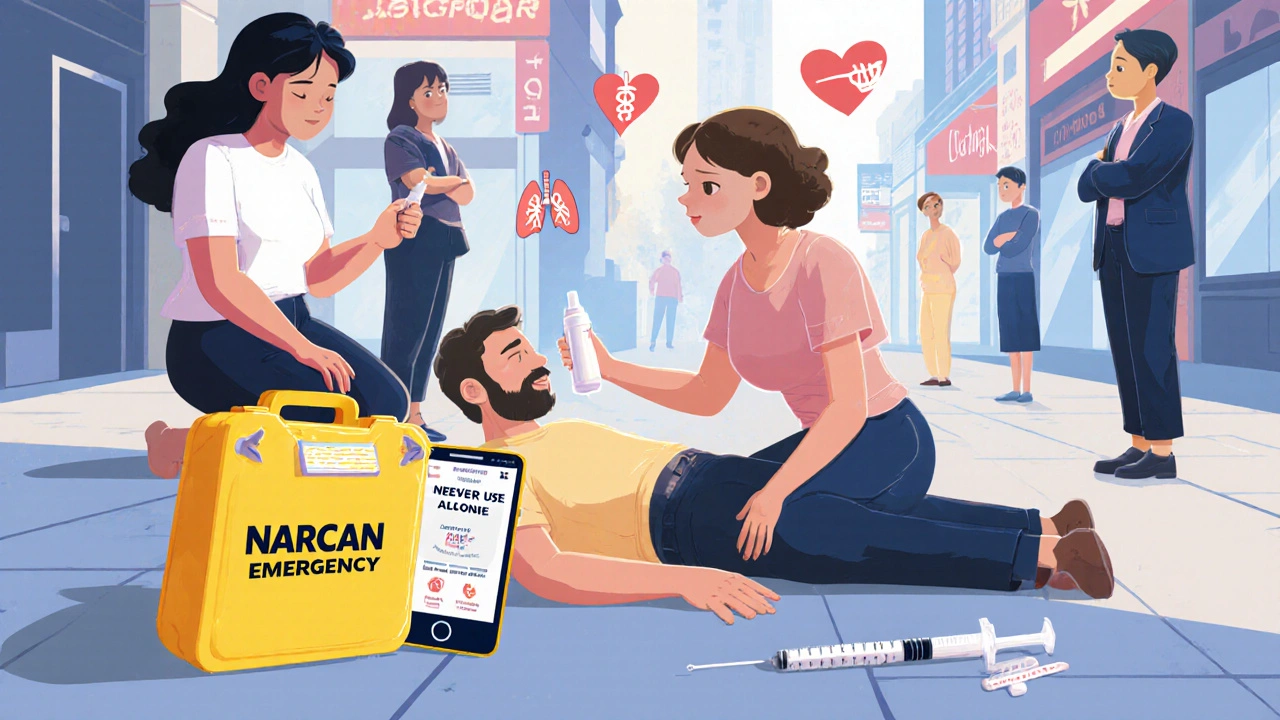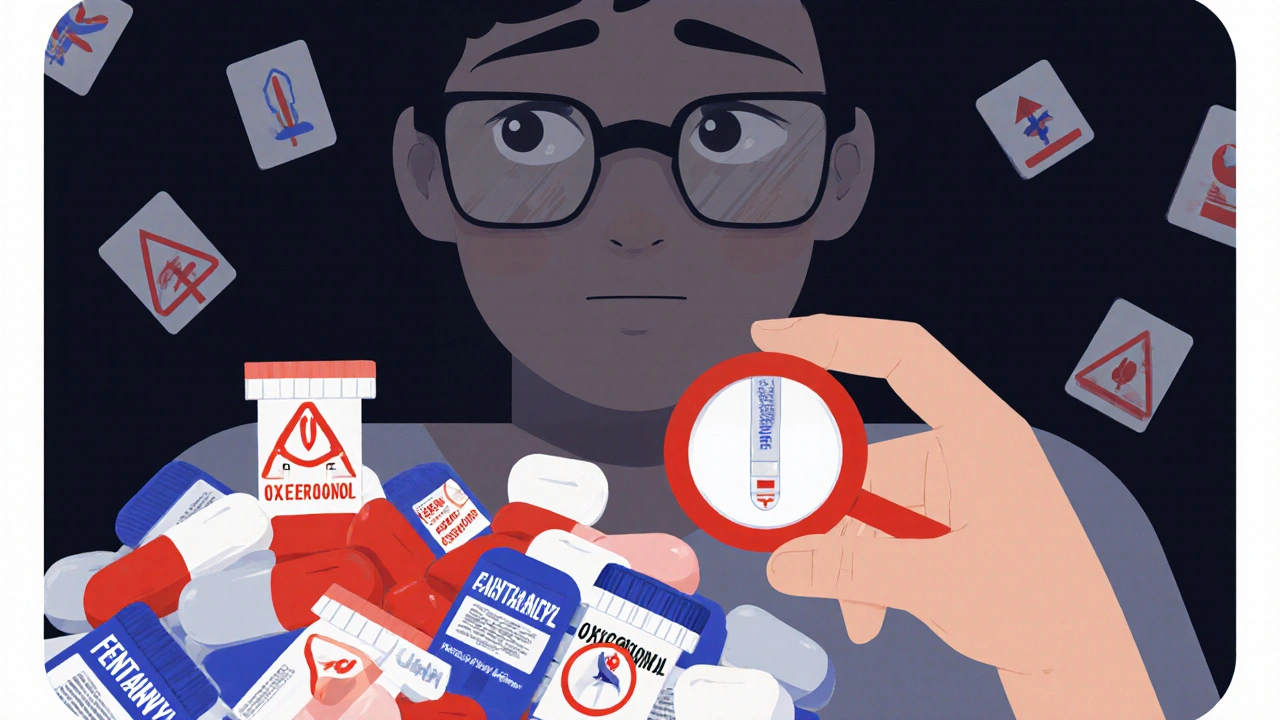Overdose deaths are the leading cause of injury-related death in the U.S. Every day, more than 150 people die from drug overdoses - many of them from fentanyl-laced pills or powders they didn’t know were poisoned. If someone you care about has a substance use disorder, you might feel powerless. But you’re not. There are real, proven ways to prevent overdose - and they work.
Know the Real Danger: Fentanyl Is Everywhere
Fentanyl isn’t just another drug. It’s 50 to 100 times stronger than morphine. And it’s not always labeled. A pill you think is oxycodone? Could be fentanyl. A bag of powder you believe is heroin? Could be fentanyl. A fake Adderall? Also fentanyl. In 2022, fentanyl was involved in nearly 80% of all opioid overdose deaths. Even a tiny amount - as little as two milligrams - can kill.
What makes it worse? People don’t always know they’re using it. The Drug Enforcement Administration found that 6 out of 10 counterfeit pills seized in 2022 contained a lethal dose. And it’s not just opioids. Fentanyl is now showing up in cocaine, methamphetamine, and even MDMA. You can’t tell by looking. You can’t tell by smell. You need a test.
Carry Naloxone - It’s Simple, Safe, and Life-Saving
Naloxone (brand names Narcan, Kloxxado) is the only medication that can reverse an opioid overdose. It works by kicking opioids off brain receptors and restoring breathing. It doesn’t work on xylazine, alcohol, or benzodiazepines - but since most overdoses now involve opioids, it’s still your best bet.
You don’t need a prescription. Since March 2023, Narcan has been available over the counter at pharmacies across the U.S. It comes in two forms: a nasal spray (easy to use) and an auto-injector. The nasal spray requires no training. Just remove the cap, insert it into one nostril, and press the plunger. That’s it.
Studies show 96% of people trained for just 20 minutes can successfully administer it. And it’s safe. If someone isn’t having an opioid overdose, naloxone won’t hurt them. Keep it in your bag, your car, your coat pocket. If you’re worried about someone using alone, give them a dose before they go. One dose of Narcan costs about $45 - and it can save a life.
Use Fentanyl Test Strips Before Using
Test strips are small, cheap, and surprisingly accurate. For under $2 each, you can test a tiny sample of any drug - powder, pill, or liquid - for fentanyl. You dip the strip in water with a bit of the substance, wait 90 seconds, and check for a line. One line? Fentanyl is present. Two lines? No fentanyl detected.
They detect fentanyl at levels as low as 0.25 nanograms - far below the lethal dose. But they’re not perfect. False negatives can happen if the sample isn’t mixed well or if the drug is too diluted. Still, they give people control. A 2022 study found that people who used test strips were 30% more likely to avoid using if fentanyl was detected.
They’re legal in most states. You can order them online from harm reduction groups like DanceSafe or The Loop. Some syringe exchange programs give them out for free. If someone you know uses drugs, give them a pack. Ask them to test before each use. It’s not about stopping them - it’s about keeping them alive.

Medication-Assisted Treatment (MAT) Works - But Most People Can’t Get It
The most effective way to prevent overdose long-term is treatment - specifically, medication-assisted treatment (MAT). MAT combines FDA-approved medications with counseling. The three main drugs are:
- Methadone - taken daily at a clinic. Keeps cravings and withdrawal at bay.
- Buprenorphine - taken as a pill or film under the tongue. Can be prescribed by many doctors.
- Naltrexone - a monthly injection or daily pill. Blocks opioids from working.
WHO and CDC both say MAT cuts overdose deaths by about 50%. People on MAT are more likely to stay in treatment, hold jobs, and reconnect with family. But here’s the problem: only 18% of U.S. counties have access to all three medications. In rural areas, 60% of counties have no MAT provider at all. That’s a crisis within a crisis.
If someone you know wants help, start with buprenorphine. Many primary care doctors can prescribe it now, thanks to relaxed federal rules. Call your local health department or visit the SAMHSA treatment locator. Don’t wait for a specialist. Ask your doctor. Ask a nurse. Ask anyone who works in healthcare.
Never Use Alone - And Know the Emergency Plan
Most overdoses happen alone. That’s why the “Never Use Alone” hotline exists. Call it before you use. Someone stays on the line with you. If you stop responding, they call 911. In 2023, they handled 12,000 overdose incidents a month. That’s 360,000 calls a year - and hundreds of lives saved.
Build a safety plan. Write it down. Who will you call? Where’s your naloxone? What’s your address? What drug are you using? What’s your weight? All of this helps first responders. The New York State Department of Health found that people who used a written safety plan had 28% fewer overdoses.
Teach your loved ones how to use naloxone. Practice on a dummy spray. Keep extra doses in the house. Make sure they know to call 911 even after giving naloxone - because the effects wear off in 30 to 90 minutes, and the drug might still be in their system.

What About Xylazine? It’s Not Reversible
There’s a new threat: xylazine, also called “tranq.” It’s a veterinary sedative now mixed into street drugs. It doesn’t respond to naloxone. It causes severe skin sores, slow breathing, and long unconsciousness. In 2022, the DEA found xylazine in 23% of fentanyl powder and 7% of fentanyl pills.
There’s no antidote yet. But you can still reduce harm. Use test strips to check for fentanyl - since xylazine is almost always mixed with it. Don’t use alone. Use smaller amounts. Watch for signs like extreme drowsiness, slow breathing, or cold, pale skin. Call 911 immediately. Emergency crews are learning how to treat it - but they need to know what they’re dealing with.
Access Is Still the Biggest Barrier
Stigma kills. 41% of people with substance use disorders don’t seek help because they’re afraid of being judged. That’s not just sad - it’s deadly. Naloxone is free in many places. MAT is covered by Medicaid. But if you don’t know where to go, you won’t get it.
Call your local harm reduction center. Search for “needle exchange near me.” Go to a community health clinic. Ask about peer support. Many people who’ve been through addiction now work as counselors - and they get it. They’ve been there.
And if you’re not sure where to start, here’s a quick list:
- Get naloxone - now. Buy it at CVS, Walgreens, or Walmart.
- Order fentanyl test strips - they’re cheap and legal.
- Learn how to use both.
- Ask your doctor about buprenorphine.
- Encourage the people you care about to use with someone else.
- Keep the conversation open - no shame, no judgment.
Overdose isn’t inevitable. It’s preventable. And the tools to stop it already exist. You don’t need to be a doctor. You don’t need to be perfect. You just need to act.
Can naloxone be used on someone who didn’t take opioids?
Yes, and it’s safe. Naloxone only works if opioids are present. If someone has taken alcohol, benzodiazepines, or stimulants, naloxone won’t harm them - it just won’t do anything. That’s why it’s safe to give to anyone showing signs of overdose, even if you’re not sure what they took.
Is fentanyl test strip use legal in all states?
In most states, yes. Fentanyl test strips are not classified as drug paraphernalia under federal law. However, a few states have unclear or restrictive laws. If you’re unsure, contact your local harm reduction organization. They can tell you the rules in your area and often provide strips for free.
Can I get MAT without insurance?
Yes. Medicaid covers MAT in all states. If someone doesn’t have insurance, they may qualify for free or low-cost treatment through state-funded programs. Community health centers and public hospitals often offer sliding-scale fees. Call SAMHSA’s helpline at 1-800-662-HELP - they’ll connect you to local options.
Why isn’t naloxone more widely available in pharmacies?
It is - but not everywhere. Since March 2023, Narcan has been approved for over-the-counter sale, and most major pharmacies now stock it. However, some rural or small-town pharmacies still don’t carry it due to cost, lack of demand, or staff training gaps. If your pharmacy doesn’t have it, ask them to order it. You can also buy it online from reputable distributors or get it for free from local harm reduction groups.
What should I do if someone overdoses and I don’t have naloxone?
Call 911 immediately. Then, start rescue breathing: tilt the head back, pinch the nose, and give one breath every 5 seconds. Keep going until help arrives or the person starts breathing on their own. Don’t wait. Don’t try to make them walk it off. Don’t put them in a cold shower. Time matters. Rescue breathing can keep oxygen flowing until emergency responders get there.
Does MAT just replace one drug with another?
No. That’s a myth. Methadone and buprenorphine are not recreational drugs. They stabilize brain chemistry, reduce cravings, and allow people to function normally - work, parent, drive, study. People on MAT aren’t “addicted” to their medication - they’re being treated for a medical condition, just like someone with diabetes takes insulin. Studies show people on MAT are far more likely to stay alive and rebuild their lives.
